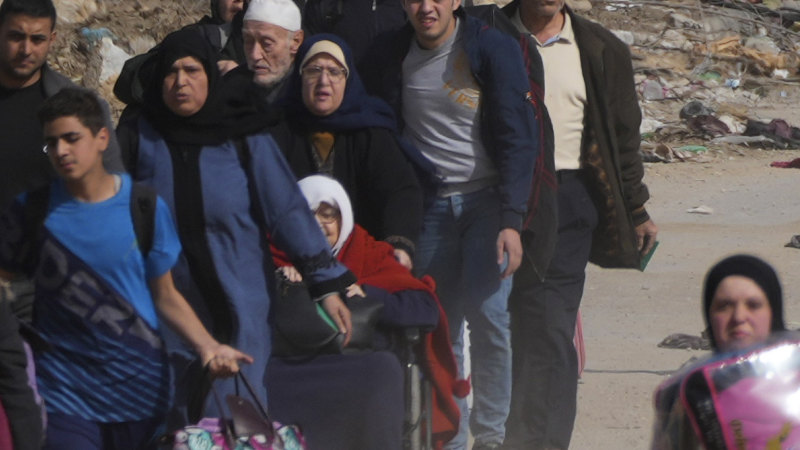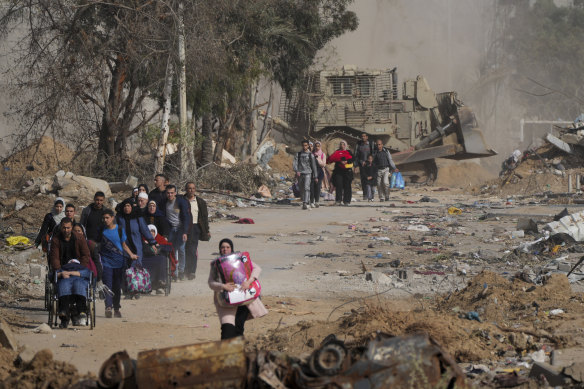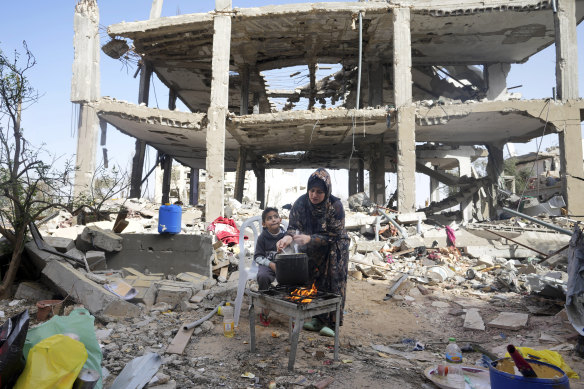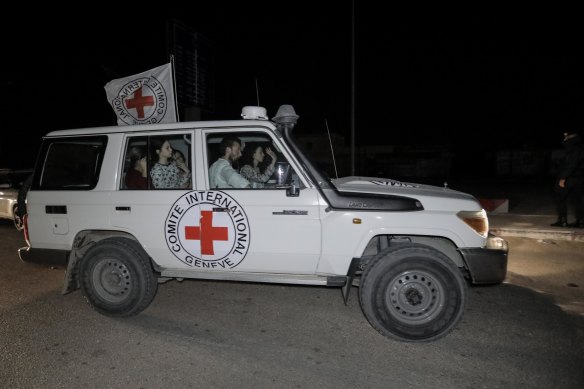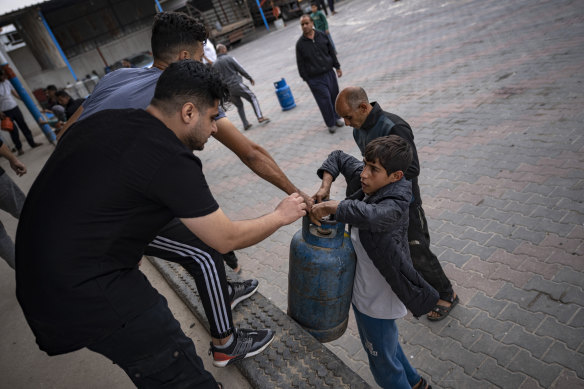Save articles for later
Add articles to your saved list and come back to them any time.
The fragile ceasefire between Israel and Hamas appeared to holding on Sunday, ensuring a third hostage-prisoner swap was able to proceed as civilians in Gaza welcomed respite from the war.
Reuters news agency reported that Hamas had handed to the Red Cross 13 Israeli hostages, three Thai nationals and one Russian. Egypt said earlier said it had received lists of 13 Israelis and 39 Palestinians scheduled for release.
The Israeli Defence Forces said 14 Israelis had been released, but the differing numbers were reported to be the result of the Russian citizen having dual nationality.
Palestinians flee south on the third day of a ceasefire between Israel and Hamas.Credit: AP
The third release followed a second prisoner-hostage exchange on Saturday night that risked being derailed when Hamas’ armed wing claimed that Israel had failed to meet all truce conditions, including committing to letting aid trucks into northern Gaza.
Saving the deal took a day of diplomacy mediated by Qatar and Egypt, and with involvement from US President Joe Biden.
COGAT, the Israeli agency for civilian coordination with the Palestinians, accused Hamas of delaying the trucks trying to deliver humanitarian aid to northern Gaza at a checkpoint.
The killing of a Palestinian farmer in the central Gaza Strip had earlier added to concerns over the fragility of the truce.
Palestinian woman Hiyam Qudih cooks in front of her family’s destroyed building in the village of Khuza’a, east of Khan Younis in the Gaza Strip.Credit: AP
The farmer was killed when targeted by Israeli forces east of Gaza’s long-established Maghazi refugee camp, the Palestinian Red Crescent said.
There was no comment from Israel on the report, but there were fears it could jeopardise the third prisoner-hostage exchange.
However, Diaa Rashwan, the head of Egypt’s State Information Service, said the truce was “proceeding without roadblocks”.
Rashwan said 120 aid tucks crossed from Egypt to Gaza on Sunday, including two fuel trucks and two with gas for cooking.
The aid was expected to provide welcome respite for civilians in Gaza left displaced by weeks of bombardment following Hamas’ rampage through southern Israel on October 7.
The incursions, which resulted in at least 1200 deaths in Israel and saw Hamas capture some 240 hostages, led to an Israeli aerial and ground assault on Gaza.
Israel has vowed to destroy the Hamas militants who run Gaza, bombarding the enclave and mounting a ground offensive in the north. Some 14,800 Palestinians have been killed, Gaza health authorities say, and hundreds of thousands displaced.
Hostages released during the second prisoner-hostage exchange were transported in International Committee of the Red Cross vehicles from the Gaza Strip on Saturday night.Credit: Getty Images
The armed wing of Hamas also said on Sunday that since the war erupted, four of its military commanders in the Gaza Strip had been killed, including the commander of the North Gaza brigade, Ahmad Al Ghandour. It did not say when or how they had been killed.
Thirteen Israelis and four Thai nationals arrived in Israel early on Sunday after the second release of hostages.
Egypt and Qatar acted as mediators on Saturday to maintain the truce.
Possibility of truce extension
Qatar, Egypt and the United States are pressing for the four-day truce to be extended beyond Monday, but it is not clear whether that will happen.
Israel had said the ceasefire could be extended if Hamas continued to release at least 10 hostages a day. A Palestinian source had said up to 100 hostages could go free.
Six of the 13 Israelis released on Saturday were women and seven were teenagers or children. The youngest was three-year-old Yahel Shoham, freed with her mother and brother, although her father remains a hostage.
Israel freed 39 Palestinians – six women and 33 teenagers – from two prisons, the Palestinian news agency WAFA said.
Some of the Palestinians arrived at Al-Bireh Municipality Square in Ramallah in the Israeli-occupied West Bank, where thousands of citizens awaited them, a Reuters journalist said.
Violence flared in the West Bank where Israeli forces killed seven Palestinians, including two minors and at least one gunman, late on Saturday and early Sunday, medics and local sources said.
Palestinians line up for cooking gas in Khan Younis in the Gaza Strip during the temporary ceasefire between Hamas and Israel.Credit: AP
Even before the October 7 attacks from Gaza, the West Bank had been in a state of unrest, with a rise in Israeli army raids, Palestinian attacks, and violence by Israeli settlers in the past 18 months. More than 200 Palestinians have been killed in the West Bank since October 7, some in Israeli air strikes.
Saturday’s swap follows the previous day’s initial release of 13 Israeli hostages, including children and the elderly, by Hamas in return for the release of 39 Palestinian women and teenagers from Israeli prisons.
The four Thais freed on Saturday wanted a shower and to contact their relatives, Thailand’s Prime Minister Srettha Thavisin said on social media platform X, formerly Twitter All were safe and showed few ill-effects, he said.
Days of calm in Gaza
The truce allowed some respite for Gazans such as Ibrahim Kaninch, who sat by a small bonfire outside his partially destroyed house, feeding the flames with bits of cardboard as he heated up water for tea.
“We’re living days of calm, where we are stealing moments to make tea,” he said, his face lit by the glow of the fire in Khan Younis in southern Gaza.
“These truce days have allowed people to have a bit of social communication and to check on their families and friends and their houses.”
Kaninch lives in Khan Younis, a town in the southern Gaza Strip where tens of thousands of people have sought refuge in tents, schools and residents’ homes after fleeing heavy bombardment in the northern half of the territory.
However, air strikes have also hit many targets in the south, and Kaninch said the constant terror and the sound of military jets and explosions made it impossible to have a quiet evening whether inside or out until the truce.
He was enjoying the break from the fear and noise, but with his home badly damaged by a strike, the situation was still very far from normal. Kaninch mused that the war had revived aspects of the lifestyle of earlier generations.
“We’ve lost this kind of gathering around the fire years ago, but the exceptional status of war that we’re currently experiencing has brought back some of the heritage and the social culture that our ancestors used to have,” he said.
Nearby, a man pushing a bicycle and a woman carrying a baby strolled side by side in the darkened street as the call to prayer could be heard faintly in the distance. The headlights of a passing car briefly lit up piles of rubble on the street and graffiti on the walls.
“We ask ourselves what’s next? There’s no electricity or water, there are shortages of all basic human needs,” said Kaninch.
“We ask God to let people’s lives resume and go back to safety, peace and prosperity.”
Reuters, AP
Get a note directly from our foreign correspondents on what’s making headlines around the world. Sign up for our weekly What in the World newsletter.
Most Viewed in World
From our partners
Source: Read Full Article
